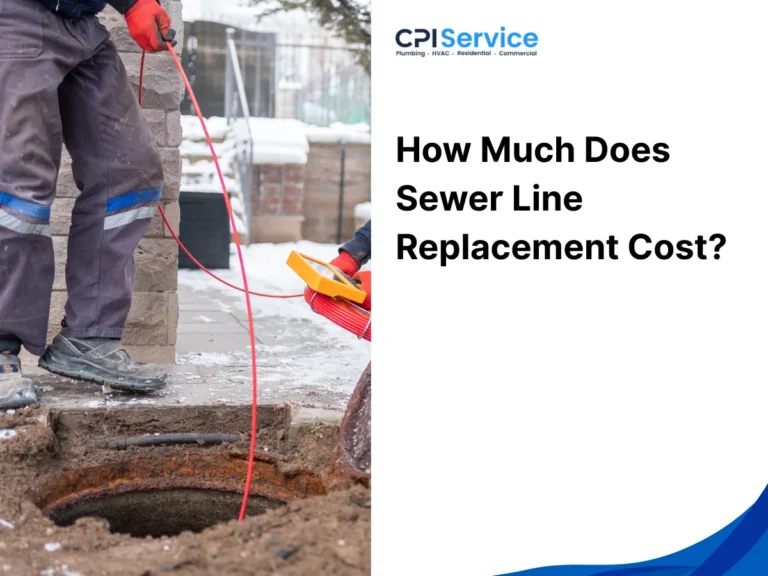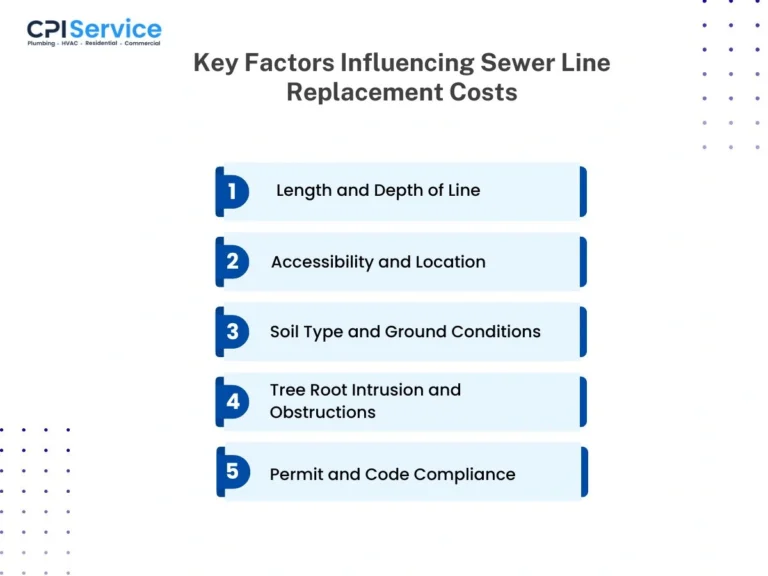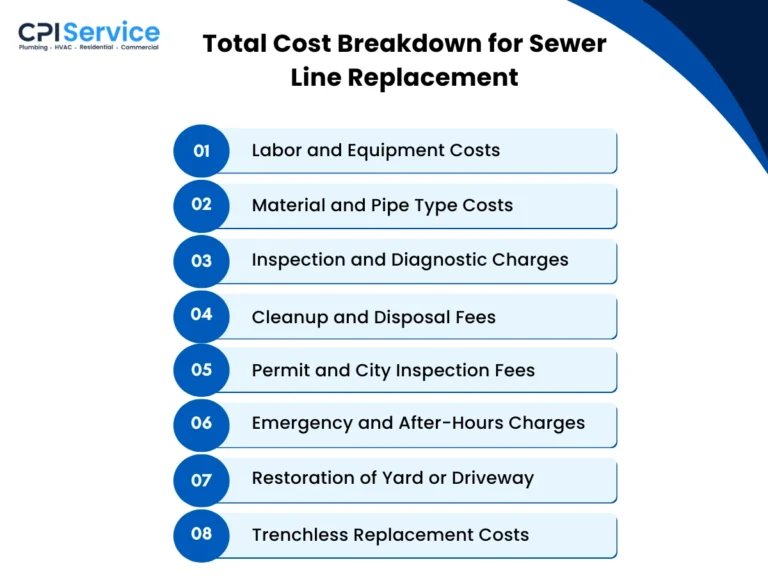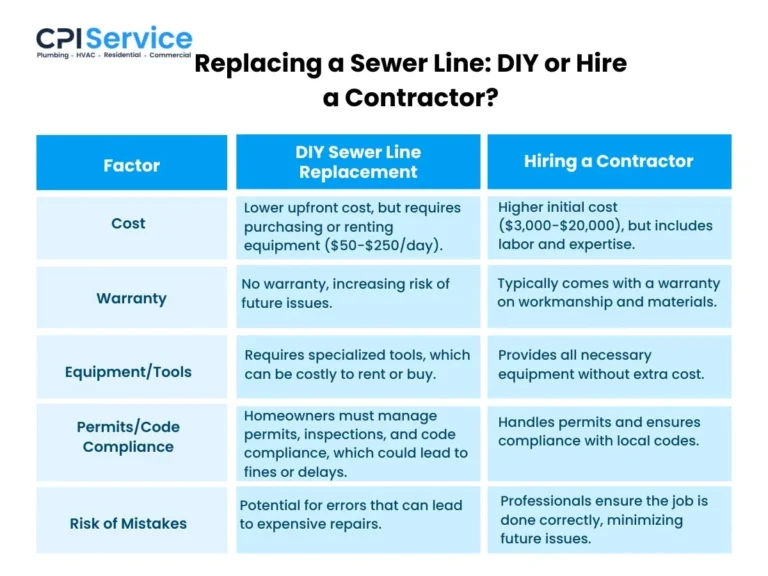How Much Does Sewer Line Replacement Cost?
The cost of sewer line replacement typically ranges from $3,000 to $12,000, with the final price exceeding $25,000 for complex situations. This cost includes labor, materials, excavation, and necessary permits, all of which contribute to the overall price.
Several technical factors influence sewer line replacement costs, including depth and length, which are typically priced at $50 to $250 per linear foot. Shallow lines are less expensive to replace, while deeper lines require more excavation and specialized equipment, increasing the cost. The choice of pipe material, PVC, cast iron, or HDPE, also impacts pricing, as does the method used. Trenchless methods, priced between $80 and $250 per foot, can reduce labor and restoration costs but tend to be more expensive than traditional digging.
Site accessibility is another important factor. If the sewer line is located beneath a driveway, sidewalk, or other hard-to-reach areas, additional labor and equipment will be needed to access and remove these obstructions. Moreover, local regulations and permitting requirements can influence costs, as some municipalities charge substantial fees for permits and inspections.

Key Factors Influencing Sewer Line Replacement Costs
Sewer line replacement costs vary based on factors such as line depth, accessibility, soil type, and required permits. Deeper lines require more excavation and equipment, while lines under driveways or landscaping add labor costs. Rocky or clay-heavy soil increases time and equipment needs, further raising costs. Additionally, local permits and code compliance can add fees and extend the timeline, contributing to overall cost variation.

Length and Depth of Line
The length and depth of the sewer line are critical factors that directly affect both the cost and complexity of replacement. Longer and deeper lines require extensive excavation, often with the need for heavy machinery such as excavators or trenching machines, and increased labor for digging and backfilling. Shallow lines are typically easier and less expensive to replace, with standard installation costs ranging from $50 to $250 per linear foot. For deeper lines, typically exceeding 5 feet, additional techniques such as trench shoring and the use of specialized equipment are required, which drive up the cost. As depth and length increase, so does the overall project cost, reflecting both labor and material requirements.
Accessibility and Location
The accessibility and location of the sewer line can significantly increase replacement costs, as hard-to-reach lines require additional labor and specialized equipment. Sewer lines buried beneath driveways, sidewalks, or dense landscaping often require cutting and removal of these surfaces, which adds extra labor costs. Depending on the complexity of the site, contractors may need to use mini-excavators, vacuum excavation, or other specialized tools, raising the cost. Access issues generally increase labor rates, often ranging from $50 to $150 per hour, as they require extra time and effort to clear the area and safely replace the line. A more accessible location typically results in lower labor and equipment costs, making this a key consideration when estimating project costs.
Soil Type and Ground Conditions
The type of soil and the ground conditions in which the sewer line is located can greatly affect both the cost and time required for replacement. Rocky or dense soil demands specialized equipment, such as jackhammers or pneumatic drills, to break through, increasing both time and labor costs. Clay-heavy soil, known for its resistance to excavation, requires more time to dig and may require additional tools, further raising costs. Wet or waterlogged soil can also complicate the excavation process, necessitating dewatering or drainage systems, which adds to the cost. In such conditions, excavation costs can increase by $500 to $2,000, depending on the specific ground conditions.
Tree Root Intrusion and Obstructions
Tree root intrusion is one of the most common issues encountered during sewer line replacement, particularly in older lines made from materials like clay or cast iron. When roots infiltrate the pipes, they can cause severe blockages and structural damage, leading to significant additional work for removal. This typically involves root cutting, hydro-jetting, or even pipe replacement, which can cost between $500 and $1,500 depending on the severity and extent of the intrusion. Furthermore, other obstructions such as legacy debris or unmarked utility lines may be encountered, requiring extra effort and potentially adding to the total cost of the project.
Permit and Code Compliance
Securing the proper permits and ensuring compliance with local building codes is a crucial aspect of any sewer line replacement. Many municipalities require permits to ensure the work meets safety and environmental standards. These permits can range from $100 to $500, depending on the location. In addition to the permit costs, adhering to local codes may require modifications to the original plans, such as upgrading old pipes or installing additional safety features. Failure to obtain proper permits or comply with code regulations can lead to fines, delays, and even the need to redo work, which can significantly increase project costs.
Total Cost Breakdown for Sewer Line Replacement
The total cost of sewer line replacement is influenced by various elements, including labor, materials, equipment, permits, inspections, and site restoration. Each of these factors contributes to the overall cost, and understanding them is essential for homeowners to budget effectively. Below is a detailed breakdown of how these components affect the total price of replacing a sewer line.

Labor and Equipment Costs
Labor and equipment are among the largest components of sewer line replacement costs. On average, labor costs can range from $50 to $150 per hour, depending on the complexity of the job and the contractor’s rates. Larger crews may be required for more difficult jobs, and in some cases, heavy equipment like excavators, trench shoring equipment, or jackhammers may be needed to dig through tough soil or reach deep pipes. The equipment rental costs can vary from $50 to $250 per day, depending on the type of machinery required for the job.
Material and Pipe Type Costs
The choice of materials used for the new sewer pipe will significantly impact the overall cost. The most common materials include PVC, HDPE, cast iron, and cured-in-place liners (CIPP). PVC pipes typically cost between $3 and $7 per foot, while cast iron pipes can range from $10 to $30 per foot. HDPE, known for its durability, falls in the $20 to $200 per foot range. Additionally, specialized options like CIPP liners or trenchless solutions can cost anywhere from $60 to $250 per foot. These materials vary in durability, ease of installation, and cost, so the choice will depend on the specific needs of the property and soil conditions.
Inspection and Diagnostic Charges
Before replacing a sewer line, contractors typically conduct inspections using cameras to assess the condition of the pipe and identify potential issues. The cost of these diagnostic services typically ranges from $100 to $500. Sewer camera inspections are crucial for determining the extent of damage, such as root intrusion or pipe collapse, and can help contractors plan the most efficient replacement method. These inspection fees may be credited toward the total cost of the replacement if the homeowner proceeds with the full service.
Cleanup and Disposal Fees
The process of replacing a sewer line generates a significant amount of debris, including old pipes, excavated soil, and other materials. Disposal fees typically range from $200 to $500, depending on the amount of waste generated and whether the contractor includes cleanup in their overall quote. Some contractors may charge separately for hauling away debris, particularly if large amounts of concrete, asphalt, or soil need to be disposed of. Proper cleanup and disposal are essential to leaving the property in a safe and restored condition.
Permit and City Inspection Fees
Permitting and inspections are necessary parts of any sewer line replacement project, and the costs can vary significantly by location. Most municipalities require homeowners to apply for a permit, which typically ranges from $100 to $500. This fee covers the application, review, and necessary inspections required by the local government. In addition to the permit, contractors may need to schedule a pre- and post-installation inspection to ensure compliance with local building codes. Failure to obtain the necessary permits can result in fines or required rework, which adds extra costs.
Emergency and After-Hours Charges
Emergency or after-hours sewer line replacements often come with a premium charge. If a sewer line backup or failure occurs outside regular working hours, homeowners may face emergency surcharges, which typically range from 25% to 50% above the normal hourly rate. For example, if the normal rate is $100 per hour, an emergency charge could add $20 to $50 per hour. Holiday or weekend work can also be subject to additional fees, so it is important to account for these costs if the situation is urgent.
Restoration of Yard or Driveway
After the sewer line is replaced, restoration costs can arise if the work caused damage to the yard, driveway, or other surfaces. Replacing a sewer line often requires digging through driveways, landscaping, or lawns, and repairing these areas can add significant costs. For example, replacing sod in a yard can cost between $100 and $400, while repairing or replacing a concrete driveway can exceed $1,000. The extent of the restoration will depend on the scope of the excavation and whether trenchless methods, which minimize surface damage, are used.
Trenchless Replacement Costs
Trenchless sewer replacement methods, such as cured-in-place pipe (CIPP) lining and pipe bursting, offer a less invasive alternative to traditional methods by avoiding the need for extensive digging. While trenchless methods can save on restoration costs and minimize disruption, they tend to be more expensive upfront. The cost for trenchless replacement typically ranges from $80 to $250 per foot, depending on the method and materials used. While this can be more expensive than traditional excavation, the reduced labor and minimal surface restoration often make it a cost-effective choice for properties with significant landscaping or hardscape.
Replacing a Sewer Line: DIY or Hire a Contractor?

When deciding whether to replace a sewer line yourself or hire a professional, it is important to consider both the initial costs and long-term implications. While DIY projects may seem like a way to save money, they often come with risks such as the need for specialized equipment, potential mistakes, and complications related to permits and local codes. Hiring a contractor ensures the job is done safely, efficiently, and in compliance with regulations, reducing the risk of costly mistakes and future repairs.
Here is a comparison of the pros and cons of DIY vs. hiring a professional:
Factor | DIY Sewer Line Replacement | Hiring a Contractor |
Cost | Lower upfront cost, but requires purchasing or renting equipment ($50-$250/day). | Higher initial cost ($3,000-$20,000), but includes labor and expertise. |
Warranty | No warranty, increasing risk of future issues. | Typically comes with a warranty on workmanship and materials. |
Equipment/Tools | Requires specialized tools, which can be costly to rent or buy. | Provides all necessary equipment without extra cost. |
Permits/Code Compliance | Homeowners must manage permits, inspections, and code compliance, which could lead to fines or delays. | Handles permits and ensures compliance with local codes. |
Risk of Mistakes | Potential for errors that can lead to expensive repairs. | Professionals ensure the job is done correctly, minimizing future issues. |
While DIY may initially save on labor costs, the benefits of hiring a licensed contractor, such as expertise, warranties, and permit management, often outweigh the risks and challenges associated with DIY sewer line replacement.
Why Choosing a Professional for Sewer Line Replacement Is Worth the Cost?
Hiring a professional for sewer line replacement is worth the cost because it minimizes risks, ensures compliance with local codes, and guarantees a long-lasting, correctly installed system. While DIY may seem cheaper, professionals save time, avoid costly mistakes, and provide peace of mind by handling all aspects of the project, from permits to inspections. In the end, a contractor’s expertise can prevent future expenses and complications, making the higher initial cost a smart investment.
How Professionals Help You Avoid Costly Mistakes?
Professionals help avoid costly mistakes by bringing expertise and ensuring that the sewer line replacement is completed according to proper standards and local codes. Without proper knowledge, DIY efforts can lead to incorrect pipe installation, failure to meet code requirements, and property damage.
Here are some of the key ways professionals prevent mistakes:
- Proper Pipe Installation: Ensuring pipes are correctly aligned, sealed, and supported, preventing leaks and damage.
- Code Compliance: Meeting all local building codes, avoiding fines or costly rework.
- Accurate Diagnosis: Correctly identifying issues like root intrusion, soil conditions, or collapsed pipes before work begins.
- Efficient Project Management: Managing permits, inspections, and timelines to avoid delays or violations.
Access to Specialized Tools Saves Time and Money
Hiring a professional for sewer line replacement provides access to specialized tools that save both time and money. Professionals use high-end equipment like trenchless machines, pipe bursting tools, and camera inspection systems, which allow for faster, more efficient work. These tools are costly to rent or buy for a DIY project, and improper use can lead to mistakes that increase the overall cost. By using the right equipment, professionals can reduce labor costs and avoid extensive restoration work.
Here is how specialized tools save time and money:
- Trenchless Technology: Minimizes digging, reducing restoration costs and project time.
- Pipe Bursting: Replaces pipes without digging up the entire line, preserving landscaping.
- Camera Inspections: Identifies issues before starting, preventing unnecessary work.
- Advanced Excavation Equipment: Speeds up excavation and ensures accuracy in difficult soil conditions.
Ways to Reduce Sewer Line Replacement Costs
While sewer line replacement is a significant investment, there are several ways homeowners can reduce costs without compromising on quality. By taking proactive steps, such as requesting multiple estimates, opting for trenchless methods, or preparing the yard in advance, homeowners can save money while ensuring the job is done right. Here are a few strategies to help lower the overall cost of sewer line replacement:
Requesting Multiple Estimates
One of the easiest ways to save money on sewer line replacement is to request multiple estimates from different contractors. This allows homeowners to compare prices and services to ensure they are getting the best value. Obtaining at least 3-5 quotes gives a broader view of the pricing landscape, enabling you to spot competitive rates and negotiate discounts or additional services, such as waiving cleanup fees.
Choosing Trenchless When Applicable
If your sewer line is in a location that’s difficult to access or if you want to minimize disruption, choosing a trenchless replacement method can save money. Trenchless techniques like pipe bursting and CIPP lining allow contractors to replace the pipe without digging up your yard, which significantly reduces restoration costs. Although trenchless methods may come at a higher initial cost, they are often more cost-effective in the long run due to fewer labor hours and minimal surface damage.
Scheduling in Off-Season
Scheduling your sewer line replacement during the off-season, typically in the fall or winter, can help reduce costs. Demand for contractors is lower during these months, which often results in reduced labor rates. Contractors may also offer discounts to fill their schedules during slower periods. By avoiding peak seasons, you can take advantage of lower pricing and more flexible scheduling, potentially saving a significant amount on your project.
Prepping the Yard Before Work Begins
You can cut down on labor costs and restoration fees by prepping your yard before the work starts. Removing obstacles like furniture, garden decorations, and small plants helps the crew get to work faster, reducing the time spent clearing the area. Additionally, removing mulch or flowerbeds ahead of time will save the crew from needing to do extra work to protect your landscaping. Simple preparations can lead to savings of $200 to $500 on labor and restoration costs.
Regional Variations in Sewer Line Replacement Pricing
Sewer line replacement costs can vary widely depending on the region, influenced by factors such as labor rates, local permit fees, and soil conditions. Urban areas like San Francisco see higher costs, ranging from $6,000 to $12,000, due to expensive labor, older infrastructure, and the need for specialized equipment and excavation methods. On the other hand, suburban or rural areas, like Phoenix, Arizona, generally offer lower pricing, with replacement costs ranging from $2,000 to $8,000 due to easier access and fewer regulatory requirements.
Additionally, local building codes and permit fees also play a role in cost differences. Cities with stricter regulations, like New York, may add $1,000 to $2,000 for permits and inspections, while less regulated areas typically have lower permit fees, around $50to $200. Understanding these regional variations allows homeowners to better plan and budget for sewer line replacement based on their location.
City/Region | Typical Cost Range | Factors Impacting Cost |
San Francisco, CA | $6,000 – $12,000 | High labor rates, older infrastructure, complex excavation |
Phoenix, AZ | $3,000 – $8,000 | Easier access, lower labor costs |
New York City, NY | $7,000 – $15,000 | Strict regulations, higher permit fees |
Suburban Areas | $4,000 – $8,000 | Easier access, fewer regulations |
FAQs About Sewer Line Replacement
What is the cheapest way to replace a sewer line?
The cheapest way to replace a sewer line is typically by opting for a DIY approach if you have the skills and tools, but this can be risky and may result in additional costs if mistakes occur. Alternatively, trenchless methods like pipe bursting or CIPP lining can offer savings compared to traditional excavation because they minimize the need for costly restoration and digging, often ranging from $80 to $250 per foot.
How much does it cost to replace 50 feet of sewer line?
Replacing 50 feet of sewer line can cost between $4,000 and $12,500, depending on factors like the line’s depth, soil conditions, and accessibility. The price per foot may increase for more efficient and less invasive work.
How long does a sewer line replacement take?
On average, a sewer line replacement can take up to 5 days, depending on the project’s complexity and the method used. Traditional excavation may take longer, especially if permits or site challenges arise. Trenchless methods can often shorten the timeline to 1 to 2 days by avoiding extensive digging.
Does homeowners’ insurance cover sewer line issues?
Most standard homeowners’ insurance policies do not cover sewer line replacement unless a specific service line endorsement is added. This endorsement covers issues like tree root intrusion or pipe collapse. Without it, you would typically be responsible for the full cost of replacement or repair.
How much does it cost to replace cast iron pipes?
Replacing cast iron pipes typically costs between $10 and $30 per foot. The total cost for replacing a cast iron sewer line can range from $3,000 to $10,000, depending on factors like the line’s depth, accessibility, and location. Switching to modern materials like PVC or HDPE during the replacement can reduce future maintenance needs and improve the line’s longevity.

Alex Hamilton
Alex Hamilton is the owner of CPI Service, a trusted provider of plumbing and HVAC solutions. With over 35+ years of hands-on experience in the industry, He brings deep technical expertise and a proven track record in delivering reliable installation, maintenance, and repair services. His leadership ensures that CPI Service consistently upholds the highest standards of quality, safety, and customer satisfaction.
